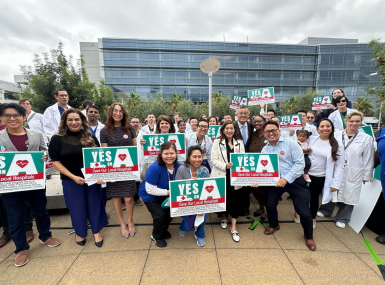Medicaid plays vital role in rural counties
Upcoming Events
Related News
Report from Georgetown examines impact of Medicaid expansion, drop in rate of uninsured children and families by state
Medicaid plays a larger role in providing health coverage to people living in small towns and rural communities than it does in metropolitan areas, a trend that is particularly striking among children, according to an extensive analysis by the Georgetown University Center for Children and Families and the University of North Carolina NC Rural Health Research Program.
Learn More
About 45 percent of children in small towns and rural areas rely on Medicaid for their coverage, compared to 38 percent in metro areas, according to the report “Medicaid in Small Towns and Rural America: A Lifeline for Children, Families and Communities.” In 14 states, more than half of the children outside of metro areas receive health benefits from Medicaid and the Children’s Health Insurance Program.
Among adults, 16 percent of those in small towns and rural America get their coverage through Medicaid, compared to 15 percent in metro areas. In 13 states, at least a fifth of the adults outside metro areas rely on Medicaid.
“Medicaid is of critical importance to people living in small towns and rural America,” said Joan Alker, a Georgetown University research professor who is executive director of the Center for Children and Families. “The trillion dollars in Medicaid cuts that Congress and the White House are considering would have an outsized impact on these communities, many of which are still struggling economically.”
The report also found that the Affordable Care Act’s Medicaid expansion is having a disproportionately positive impact on small towns and rural areas. Researchers from the two universities looked at two sets of data: health coverage in 2008-2009 and in 2014-2015.
In that time frame, the rate of uninsured adults in states that accepted the Medicaid expansion decreased 11 percentage points in non-metro areas of these states. This is larger than the decrease in metropolitan areas of expansion states (9 percentage points) and larger than the decrease in small towns and rural areas in states that did not accept the expansion (6 percentage points).
For children, the data show a clear correlation between increases in Medicaid coverage and decreases in the rate of uninsured kids in small towns and rural areas.
The uninsured rate for children in these areas declined by 3 percentage points nationally during the time period examined. Nevada had the largest decline in the rate of uninsured children — a 14 percent- point drop — in small towns and rural areas. Texas had the largest decline in the number of uninsured children, with 52,000 kids in small towns and rural areas gaining health coverage.
“The declining number of uninsured shown in our research, especially in small towns and rural areas, is striking,” said co-author Jack Hoadley, a research professor at the Georgetown University Health Policy Institute, part of the McCourt School of Public Policy. “It means that more people are protected when they need health care services.
The report provides a state-by-state breakdown of Medicaid coverage. In addition, interactive maps with county-level information are available on the Center for Children and Families website. This report primarily relies on data from the Census Bureau’s American Community Survey (ACS). For more information, visit the Rural Health Policy Project.
Attachments
Related News

CMS issues new guidance on Medicaid Community Engagement Requirements
On December 8, the Centers for Medicare & Medicaid Services (CMS) released a Medicaid and CHIP Services Informational Bulletin (CIB) directing states on how to implement the Medicaid community engagement requirements enacted under Section 71119 of the One Big Beautiful Bill Act legislation (Public Law 119-21), or H.R. 1.

California county sales tax measure backfills federal healthcare cuts
Santa Clara County, Calif. will raise an estimated $330 million each year from a sales tax to backfill lose Medicaid funding.
